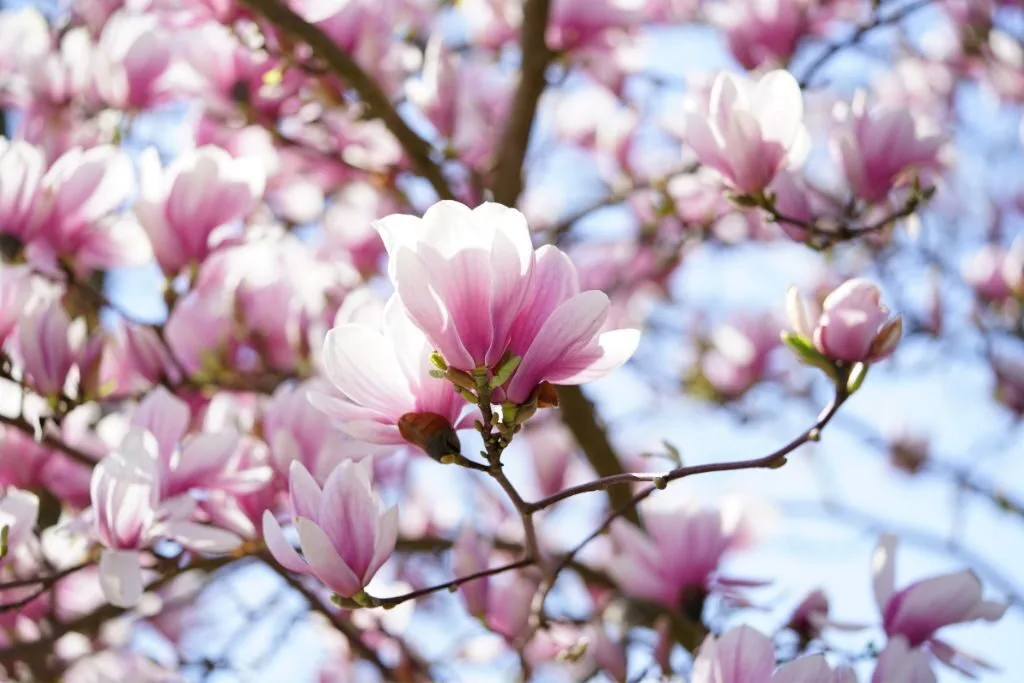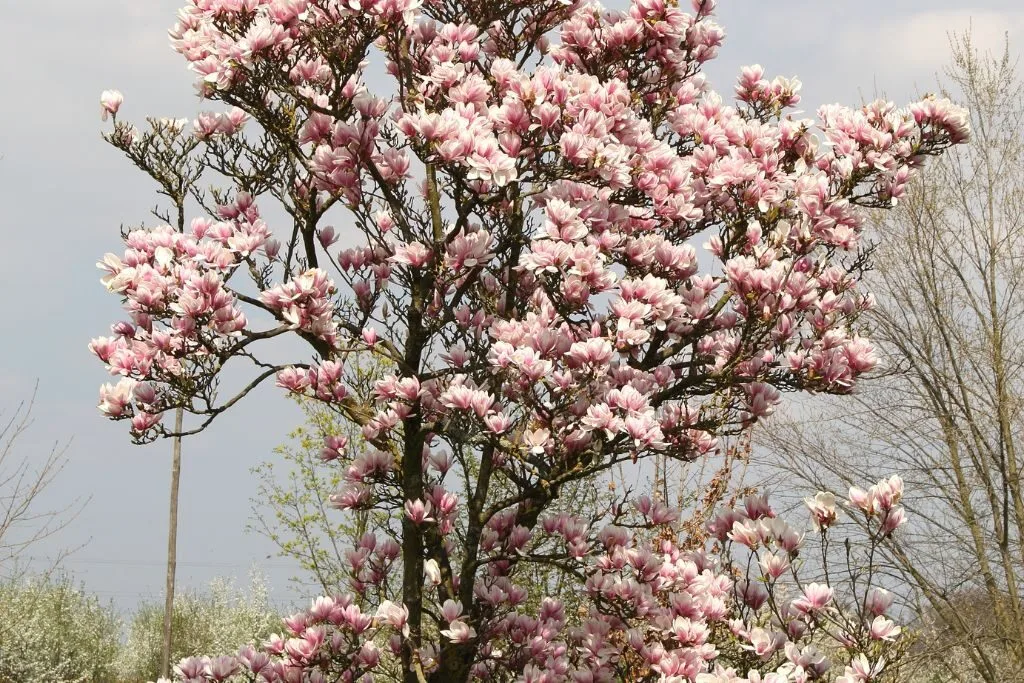Want to keep your magnolia tree in tip-top shape? Here’s our guide on how to prune a magnolia tree to help keep it looking lush and healthy.
Magnolia trees are among the most stunning ornamental flowering trees in spring and summer, with their large blooms that appear in lovely shades of pink white, purple and yellow. In general, magnolias need very little maintenance and light pruning is generally advised, but it’s still a common question nevertheless.
Key Takeaways
- There are hundreds of magnolia varieties, but only two main types: deciduous and evergreen.
- Deciduous varieties should be pruned in late summer or very early autumn after flowering.
- Evergreen varieties should be pruned in early spring before flowering
- Heavy pruning is to be avoided, and regular pruning is not usually needed unless training a young tree
- Only prune when diseased or damaged branches are present, or if a mature tree needs reshaping.
- Check the health of your magnolia regularly, including branches, bark and leaves.
Types of Magnolias
The magnolia tree or shrub is a flowering tree with over 200 varieties (and in some scientific counts, over 300). Originating in East and South Asia, it is now grown and enjoyed throughout the world for its often large bowl or star-shaped flowers in a beautiful array of colours. Some are also very fragrant plants, making them a great addition to a sensory-focused garden.
There are two main types of magnolia trees, deciduous and evergreen magnolia trees. Deciduous varieties shed their leaves each winter, whereas evergreen varieties maintain their foliage throughout the year. Pretty simple.
Deciduous magnolias
Some popular deciduous magnolia varieties include:
- Star magnolia (Magnolia Stellata), Magnolia ‘Susan’, Sweetbay magnolia (Magnolia Virginiana), and Black lily magnolia (Magnolia liliiflora ‘Nigra’).
Evergreen magnolias
Some beautiful evergreen varieties include:
- Southern magnolia (Magnolia Grandiflora) (the most well-known of evergreen varieties, with several subvarieties), Fairy Magnolia Blush and Polished-leaved magnolia (Magnolia laevifolia).
Magnolia Tree Pruning
In general, the advice for how to prune a magnolia tree is….don’t! Unlike other bushes or trees, magnolias usually need minimal regular pruning. In fact, it is generally best to avoid heavily pruning a magnolia unless the tree becomes overgrown, loses its shape, or has dead or diseased branches.
Reasons to Prune a Magnolia
There are only a few fundamental reasons to prune magnolias.
Removing diseased, damaged or dead branches helps protect the tree from further harm, prevents the spread of disease, and reduces the risk of falling debris. It’s a simple step that can make a big difference to the tree’s long-term health and safety.
Reducing the tree’s size is sometimes necessary if an overgrown magnolia is encroaching on buildings, paths, or neighbouring plants. Done carefully, this keeps the tree in proportion with its surroundings without spoiling its natural shape. This is especially important in small gardens where established magnolias can easily outgrow their space over time.
Reshaping a mature magnolia tree can improve its overall form, encourage better flowering, and allow more light and air to circulate through the canopy. This not only enhances its beauty but also supports healthier growth.
Training young magnolias sets them up for a strong, balanced structure right from the start. By guiding their growth in the early years, you can avoid the need for heavy corrective pruning later on, allowing the tree to develop naturally into a graceful, well-formed specimen.
Best Time to Prune
The best time of the year to prune your magnolia and maintain its displays of stunning flowers depends on the type of tree (deciduous or evergreen) and when the individual variety flowers. In general, you want to avoid autumn and winter for both types.
Deciduous trees and shrubs are best pruned in late summer or early autumn, right after they have finished flowering. By pruning at this time, you are setting your plant up for success in the coming seasons, ensuring it remains healthy and vigorous.
Evergreen magnolia varieties should be pruned in early spring before flowering to encourage healthy growth and maintain an attractive shape. This allows more sunlight and air circulation to reach the tree, promoting better blooming and overall health. Additionally, pruning at this time also ensures that you won’t accidentally cut off any potential flower buds that will soon bloom, leading to a more vibrant display of foliage and eventually flowers.

How to prune
While there may be a best time to prune your evergreen and deciduous magnolia trees, proper pruning techniques are the same for both. Survey the tree and gently use clean, hand pruning shears or a pruning saw to remove any dying, dead, diseased, or weak branches. Make sure to cut the branches about a quarter of an inch from the side shoot for a clean cut. If pruning a tree to significantly reduce its size,, you may have to do a staged reduction over several years to ensure you don’t shock the tree and reduce its health and vigour.
If you wish to train a young magnolia tree, ensure you attach supports to which you can attach the branches. A trellis and horizontal wires are a simple and cost-effective way to position a magnolia close to a sunny wall. You can tie the large branches at 45 degrees for the first season, and then lower them to horizontal for the second. This encourages flowering and promotes the branches to spread across your structure. You can then cut back any shoots growing inwardly towards the wall in the summer months, but avoid pruning too heavily.
For both training young trees and pruning mature magnolias, remove suckers and water sprouts (vertical shoots) to reduce the canopy and improve air flow. These extra sprouting branches can slow down your tree’s growth.
For thicker branches, consider fork-pruning by cutting back one of the forked branches to its junction point. This technique reduces the tree’s width and weight and helps shape the tree, often resulting in a more compact, “A’-shaped form. But be wary of doing this too frequently or on several points of the tree at once, as this can slow growth considerably. This should only be considered for very mature, overgrown trees.
Common Pruning Mistakes
As the general advice is ‘less is more’ in the case of magnolias, you can easily avoid most common pruning mistakes that befall other tree pruning.
- Avoid heavy pruning – The most important one to follow! For most magnolia trees, focus on removing dead or damaged branches to keep pruning to a minimum and only remove healthy growth at the right time of the year (depending on the variety). For mature trees, it’s best to spread out any necessary pruning over several years to minimise stress to the tree.
- Don’t deadhead flowers – Magnolias shed their flowers naturally, and there is no need to deadhead or remove faded ones. It can impact the natural cycle of the tree, so it’s best avoided.
- Pruning at the wrong time of the year – Follow the advice above and avoid pruning in mid/late autumn and early/mid/late winter.
Further Tips
Review the overall health of your tree and not just the trunk or branch structure. Look at both the bark and leaves of the tree to make sure your tree continues to thrive.
Healthy magnolia bark usually feels smooth and grey. As the tree grows older, it might develop a bit more texture, which is perfectly normal, but the bark should be free from cracks, peeling, or dark, sunken spots. If you notice peeling bark, cankers, or oozing sap, it could indicate some stress or health issues that might need attention.
Healthy magnolia leaves typically have a rich, deep green colour, and a well-cared-for tree will show signs of new growth and flower buds. It’s completely normal to see some yellowing and leaf drop, especially in older leaves or during different seasons (deciduous trees naturally drop their leaves in autumn and winter).
Just keep an eye on the moisture levels and soil health, as overwatering, underwatering, and pests can cause leaf discolouration. Taking small, regular checks can help your magnolia stay happy and healthy!
Need help with pruning advice?
If you need expert advice on pruning your trees, look no further than Woodfelder Tree Care. Our team of experienced tree surgeons are here to offer guidance and assistance to help you maintain the health and beauty of your trees. Whether you’re looking to shape your trees for aesthetic purposes or to promote healthy growth, we have the knowledge and tools to get the job done.
Don’t hesitate to get in touch to learn more about our tree services or request a free quotation.

